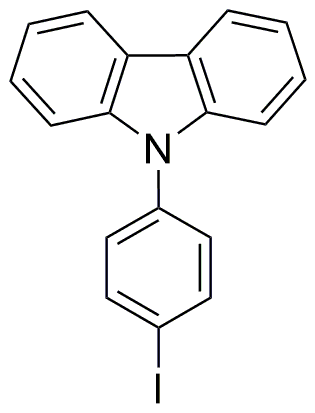9-(4-Iodophenyl)carbazole is widely utilized in research focused on:
- Organic Electronics: This compound is used in the development of organic light-emitting diodes (OLEDs), enhancing device efficiency and color purity.
- Photovoltaic Cells: It serves as a key material in organic solar cells, improving light absorption and energy conversion rates.
- Fluorescent Sensors: The compound is employed in creating sensors for detecting environmental pollutants, offering high sensitivity and selectivity.
- Pharmaceutical Research: It is explored for its potential in drug design, particularly in targeting specific cancer cells due to its unique structural properties.
- Material Science: This chemical is used in the synthesis of novel polymers, contributing to advancements in flexible electronics and high-performance materials.
Informations générales
Propriétés
Sécurité et réglementation
Applications
9-(4-Iodophenyl)carbazole is widely utilized in research focused on:
- Organic Electronics: This compound is used in the development of organic light-emitting diodes (OLEDs), enhancing device efficiency and color purity.
- Photovoltaic Cells: It serves as a key material in organic solar cells, improving light absorption and energy conversion rates.
- Fluorescent Sensors: The compound is employed in creating sensors for detecting environmental pollutants, offering high sensitivity and selectivity.
- Pharmaceutical Research: It is explored for its potential in drug design, particularly in targeting specific cancer cells due to its unique structural properties.
- Material Science: This chemical is used in the synthesis of novel polymers, contributing to advancements in flexible electronics and high-performance materials.
Documents
Fiches de données de sécurité (FDS)
La FDS fournit des informations de sécurité complètes sur la manipulation, le stockage et l’élimination du produit.
Spécifications du produit (PS)
Le PS fournit une description complète des propriétés du produit, notamment sa composition chimique, son état physique, sa pureté et les exigences de stockage. Il détaille également les plages de qualité acceptables et les applications prévues du produit.
Certificats d'analyse (COA)
Recherchez des certificats d'analyse (COA) en saisissant le numéro de lot du produit. Les numéros de lot et de lot se trouvent sur l'étiquette d'un produit, après les mots « Lot » ou « Lot de fabrication ».
Numéro de catalogue
Numéro de lot/série
Certificats d'origine (COO)
Ce certificat d'exploitation confirme le pays dans lequel le produit a été fabriqué, et détaille également les matériaux et composants utilisés et s'il est issu de sources naturelles, synthétiques ou autres sources spécifiques. Ce certificat peut être requis pour les douanes, le commerce et la conformité réglementaire.
Numéro de catalogue
Numéro de lot/série
Fiches de données de sécurité (FDS)
La FDS fournit des informations de sécurité complètes sur la manipulation, le stockage et l’élimination du produit.
DownloadSpécifications du produit (PS)
Le PS fournit une description complète des propriétés du produit, notamment sa composition chimique, son état physique, sa pureté et les exigences de stockage. Il détaille également les plages de qualité acceptables et les applications prévues du produit.
DownloadCertificats d'analyse (COA)
Recherchez des certificats d'analyse (COA) en saisissant le numéro de lot du produit. Les numéros de lot et de lot se trouvent sur l'étiquette d'un produit, après les mots « Lot » ou « Lot de fabrication ».
Numéro de catalogue
Numéro de lot/série
Certificats d'origine (COO)
Ce certificat d'exploitation confirme le pays dans lequel le produit a été fabriqué, et détaille également les matériaux et composants utilisés et s'il est issu de sources naturelles, synthétiques ou autres sources spécifiques. Ce certificat peut être requis pour les douanes, le commerce et la conformité réglementaire.


